Design of Small-Sized Spiral Slot PIFA Antenna Used Conformally in Laminated Body Tissues
Abstract
:1. Introduction
2. Antenna Topology
3. Results and Discussion
3.1. Height
3.2. Width of the Feed Line
3.3. Width of the Short Stub
3.4. Slot Width
4. Antenna Simulation and Measurement
5. Conclusions
Author Contributions
Funding
Institutional Review Board Statement
Informed Consent Statement
Data Availability Statement
Conflicts of Interest
References
- Wong, H.; Luk, K.-M.; Chan, C.H.; Xue, Q.; So, K.K.; Lai, H.W. Small Antennas in Wireless Communications. Proc. IEEE 2012, 100, 2109–2121. [Google Scholar] [CrossRef]
- Fallahpour, M.; Zoughi, R. Antenna Miniaturization Techniques: A Review of Topology- and Material-Based Methods. IEEE Antennas Propag. Mag. 2018, 60, 38–50. [Google Scholar] [CrossRef]
- Pinhas, S.; Shtrikman, S.B. Comparison between computed and measured bandwidth of quarter-wave microstrip radiators. IEEE Trans. Antennas Propag. 1988, AP-36, 1615–1616. [Google Scholar]
- Nashaat, D.M.; Elsadek, H.A.; Ghali, H. Single feed compact quad-band PIFA antenna for wireless communication applications. IEEE Trans. Antennas Propag. 2005, 53, 2631–2635. [Google Scholar] [CrossRef]
- Soh, P.J.; Vandenbosch, G.A.E.; Ooi, S.L.; Rais, N.H.M. Design of a Broadband All-Textile Slotted PIFA. IEEE Trans. Antennas Propag. 2012, 60, 379–384. [Google Scholar] [CrossRef]
- Chiu, C.Y.; Shum, K.M.; Chan, C.H. A Tunable Via-Patch Loaded PIFA With Size Reduction. IEEE Trans. Antennas Propag. 2007, 55, 65–71. [Google Scholar] [CrossRef]
- Mei, L.H.; Ming, S.S.; Hua, Z.; Bo, L.X. The effect of slots on PIFA performance. In Proceedings of the 2015 IEEE 4th Asia-Pacific Conference on Antennas and Propagation (APCAP), Bali, Indonesia, 30 June–3 July 2015; pp. 485–487. [Google Scholar]
- Zhao, A.; Ren, Z. Wideband MIMO Antenna Systems Based on Coupled-Loop Antenna for 5G N77/N78/N79 Applications in Mobile Terminals. IEEE Access 2019, 7, 93761–93771. [Google Scholar] [CrossRef]
- Chakraborty, I.; Gupta, V.R. Design and parametric study of ultra wideband PIFA Antenna. In Proceedings of the 2016 IEEE Indian Antenna Week (IAW 2016), Madurai, India, 6–10 June 2016; pp. 38–41. [Google Scholar]
- Joshna, D.; Chanthirasekaran, K. Directivity improvement of PIFA antenna at 2.7GHz by FR4 Substrate using a combination of Shorting pin and feeding pin. In Proceedings of the 2022 International Conference on Innovative Computing, Intelligent Communication and Smart Electrical Systems (ICSES), Chennai, India, 15–16 July 2022; pp. 1–5. [Google Scholar]
- Hamadi, H.B.; Ghnimi, S.; Latrach, L.; Gharsallah, A. Analysis and Design of a New PIFA Antenna for the Wireless Communications Applications. In Proceedings of the 2019 IEEE 19th Mediterranean Microwave Symposium (MMS), Hammamet, Tunisia, 31 October–2 November 2019; pp. 1–4. [Google Scholar]
- Pournoori, N.; Ma, S.; Sydänheimo, L.; Ukkonen, L.; Björninen, T.; Rahmat-Samii, Y. Small Multi-Resonant Meandered PIFA for Brain Implant Communications. In Proceedings of the 2019 8th Asia-Pacific Conference on Antennas and Propagation (APCAP), Incheon, Republic of Korea, 4–7 August 2019; pp. 79–80. [Google Scholar]
- Das, S.; Mitra, D. A Compact Wideband Flexible Implantable Slot Antenna Design with Enhanced Gain. IEEE Trans. Antennas Propag. 2018, 66, 4309–4314. [Google Scholar] [CrossRef]
- Kim, J.; Rahmat-Samii, Y. Implanted antennas inside a human body: Simulations, designs, and characterizations. IEEE Trans. Microw. Theory Tech. 2004, 52, 1934–1943. [Google Scholar] [CrossRef]
- Soontornpipit, P.; Furse, C.M.; You, C.C. Design of implantable microstrip antenna for communication with medical implants. IEEE Trans. Microw. Theory Tech. 2004, 52, 1944–1951. [Google Scholar] [CrossRef]
- Liu, C.; Guo, Y.-X.; Xiao, S. Capacitively Loaded Circularly Polarized Implantable Patch Antenna for ISM Band Biomedical Applications. IEEE Trans. Antennas Propag. 2014, 62, 2407–2417. [Google Scholar] [CrossRef]
- Kim, J.; Rahmat, Y. Planar inverted-F antennas on implantable medical devices: Meandered type versus spiral type. Microw. Opt. Technol. Lett. 2006, 48, 567–572. [Google Scholar] [CrossRef]
- Kiourti, A.; Nikita, K. Meandered Versus Spiral Novel Miniature PIFAs Implanted in the Human Head: Tuning and Performance; Springer: Berlin/Heidelberg, Germany, 2012. [Google Scholar]
- Dey, S.; Karmakar, N.C. Design of novel super wide band antennas close to the small antenna limitation theory. In Proceedings of the 2014 IEEE MTT-S International Microwave Symposium (IMS2014), Tampa, FL, USA, 1–6 June 2014; pp. 1–4. [Google Scholar]
- Amendola, S.; Moradi, E.; Koski, K.; Björninen, T.; Sydänheimo, L.; Ukkonen, L.; Rabaey, J.M.; Rahmat-Samii, Y. Design and optimization of mm-size implantable and wearable on-body antennas for biomedical systems. In Proceedings of the 8th European Conference on Antennas and Propagation (EuCAP 2014), Hague, The Netherlands, 6–11 April 2014; pp. 520–524. [Google Scholar]
- Huang, F.-J.; Lee, C.-M.; Luo, C.-H. Rectenna Application of Miniaturized Implantable Antenna Design for Triple-Band Biotelemetry Communications. IEEE Trans. Antennas Propag. 2011, 59, 2646–2653. [Google Scholar] [CrossRef]
- Lee, J.; Nam, S. Effective Area of a Receiving Antenna in a Lossy Medium. IEEE Trans. Antennas Propag. 2009, 57, 1843–1845. [Google Scholar] [CrossRef]
- Wang, J.; Leach, M.; Lim, E.G.; Wang, Z.; Pei, R.; Huang, Y. An Implantable and Conformal Antenna for Wireless Capsule Endoscopy. IEEE Antennas Wirel. Propag. Lett. 2018, 17, 1153–1157. [Google Scholar] [CrossRef]
- Harish, A.; Hidayat, M.R.; Nur, L.O.; Nugroho, B.S.; Munir, A. Spiral-shaped printed planar inverted-F antenna for body wearable application. In Proceedings of the 2017 11th International Conference on Telecommunication Systems Services and Applications (TSSA), Lombok, Indonesia, 26–27 October 2017; pp. 1–4. [Google Scholar]
- Abdi, A.; Ghorbani, F.; Aliakbarian, H.; Geok, T.K.; Rahim, S.K.A.; Soh, P.J. Electrically Small Spiral PIFA for Deep Implantable Devices. IEEE Access 2020, 8, 158459–158474. [Google Scholar] [CrossRef]
- Zhang, Y.; Liu, C.; Liu, X.; Zhang, K.; Yang, X. A Wideband Circularly Polarized Implantable Antenna for 915 MHz ISM-Band Biotelemetry Devices. IEEE Antennas Wirel. Propag. Lett. 2018, 17, 1473–1477. [Google Scholar] [CrossRef]
- Yang, Z.; Xiao, S. A single-fed miniaturized circularly polarized implantable antenna for ISM band biomedical application. In Proceedings of the 2016 IEEE MTT-S International Microwave Workshop Series on Advanced Materials and Processes for RF and THz Applications (IMWS-AMP), Chengdu, China, 20–22 July 2016; pp. 1–3. [Google Scholar]
- Abdi, A.; Aliakbarian, H. A Miniaturized UHF-Band Rectenna for Power Transmission to Deep-Body Implantable Devices. IEEE J. Transl. Eng. Health Med. 2019, 7, 1900311. [Google Scholar] [CrossRef] [PubMed]
- Kang, B.; Li, H.; Jing, D.; Ding, X. A Novel Circularly Polarized Implantable Patch Antenna for Biomedical Applications. In Proceedings of the 2022 IEEE MTT-S International Microwave Workshop Series on Advanced Materials and Processes for RF and THz Applications (IMWS-AMP), Guangzhou, China, 13–15 November 2022; pp. 1–3. [Google Scholar]
- Silue, D.; Choubani, F.; Labidi, M. Enhanced Meander antenna for in-body telemetry applications. In Proceedings of the 2022 18th International Conference on Wireless and Mobile Computing, Networking and Communications (WiMob), Thessaloniki, Greece, 10–12 October 2022; pp. 278–283. [Google Scholar]



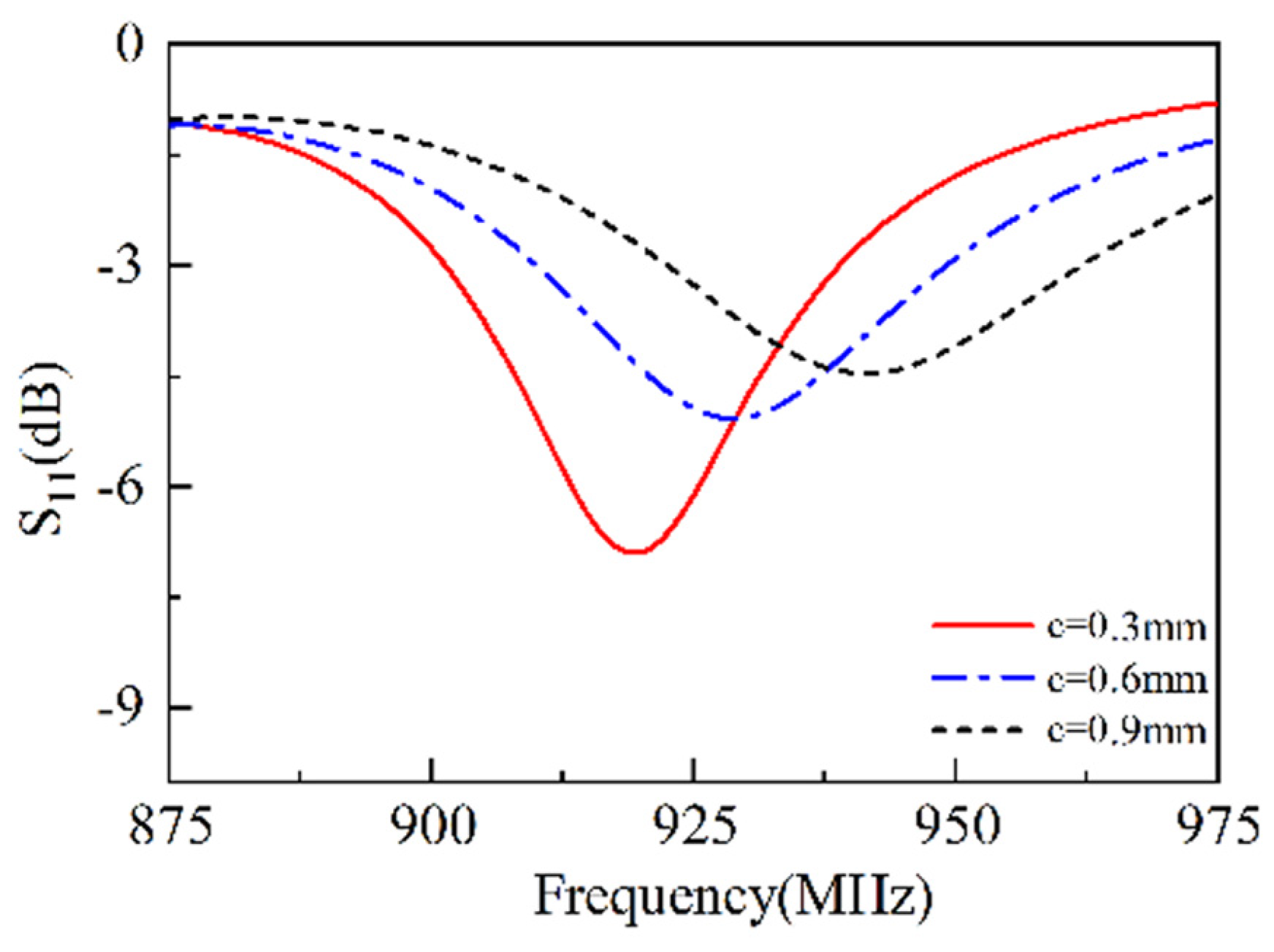
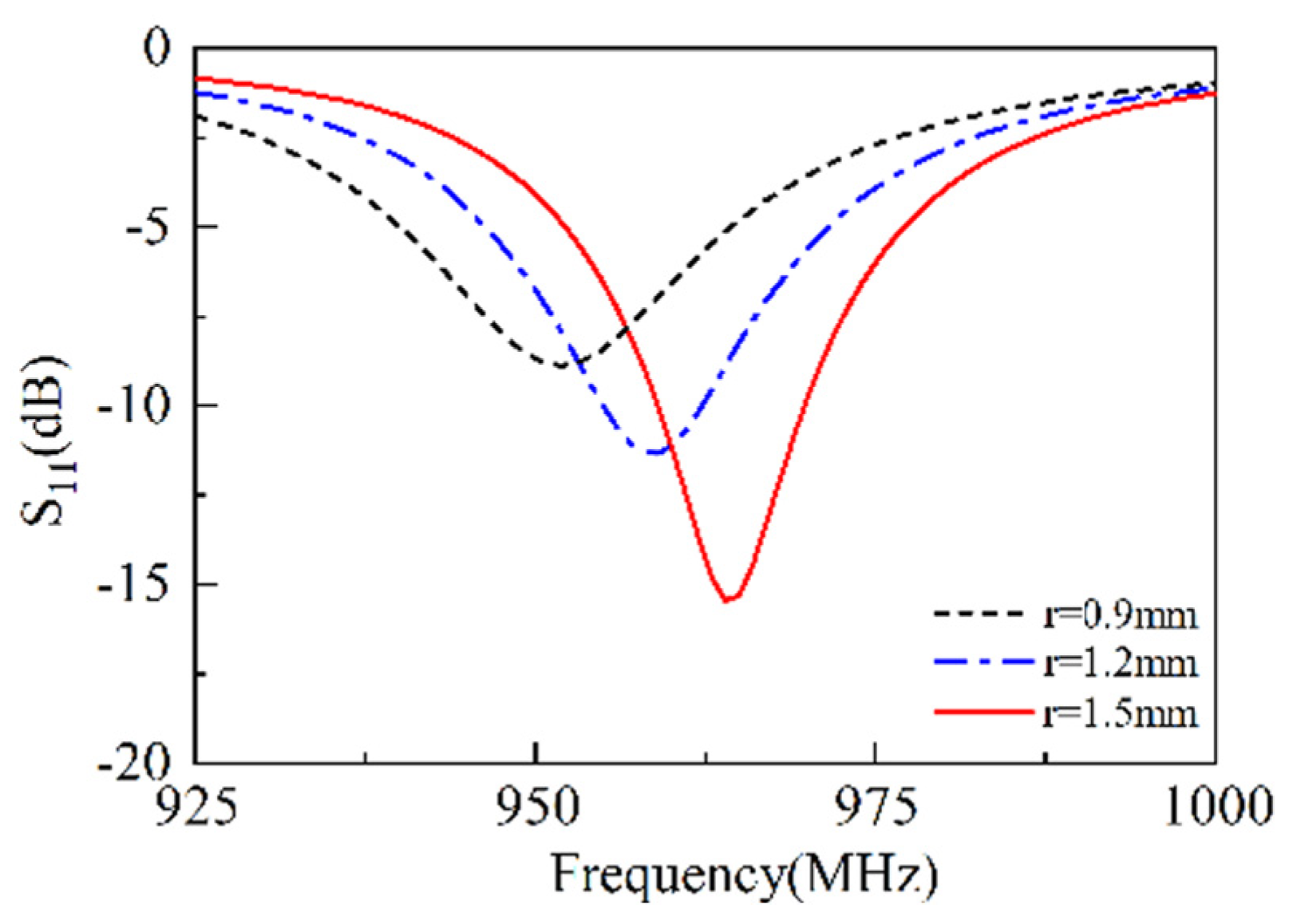


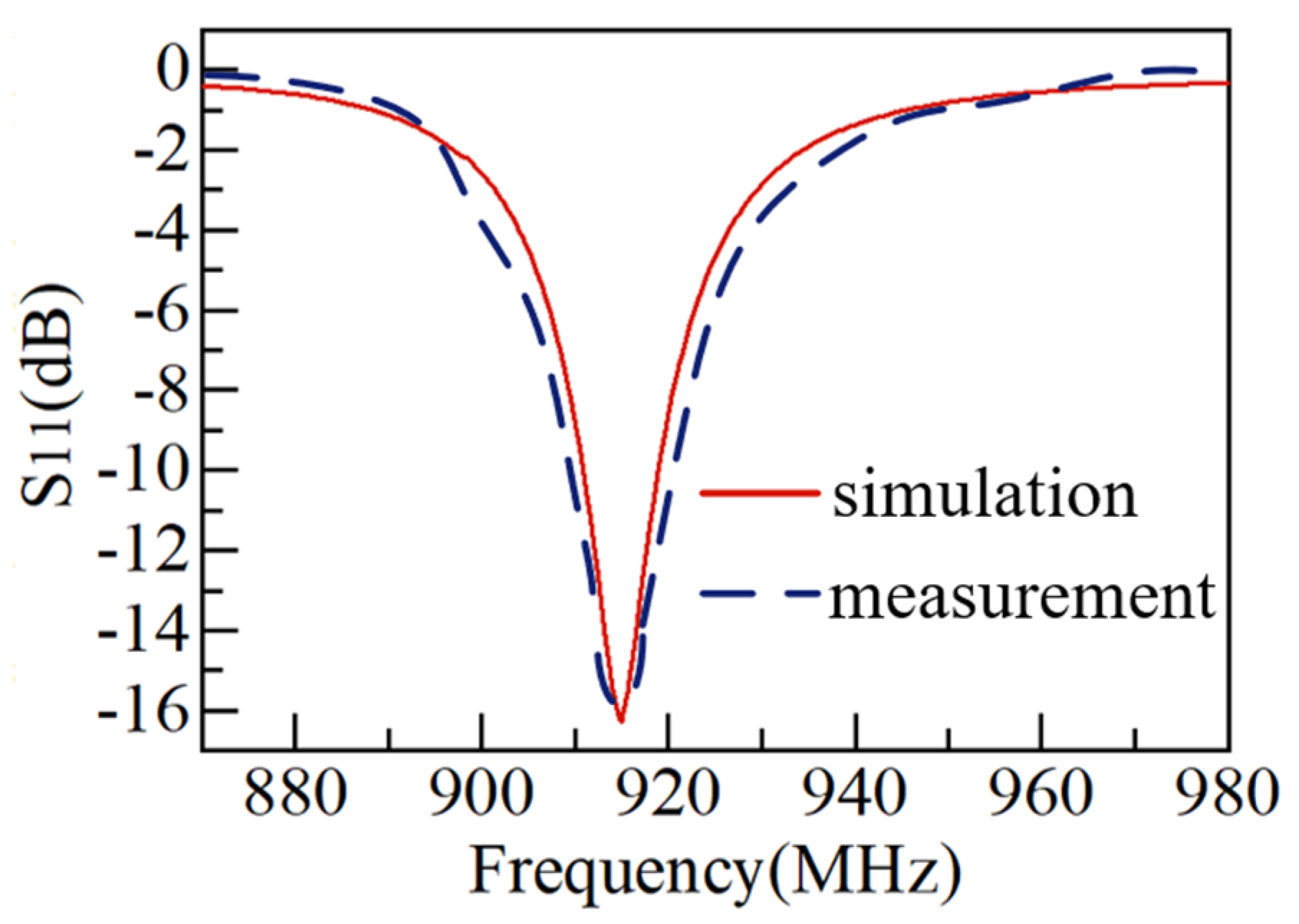
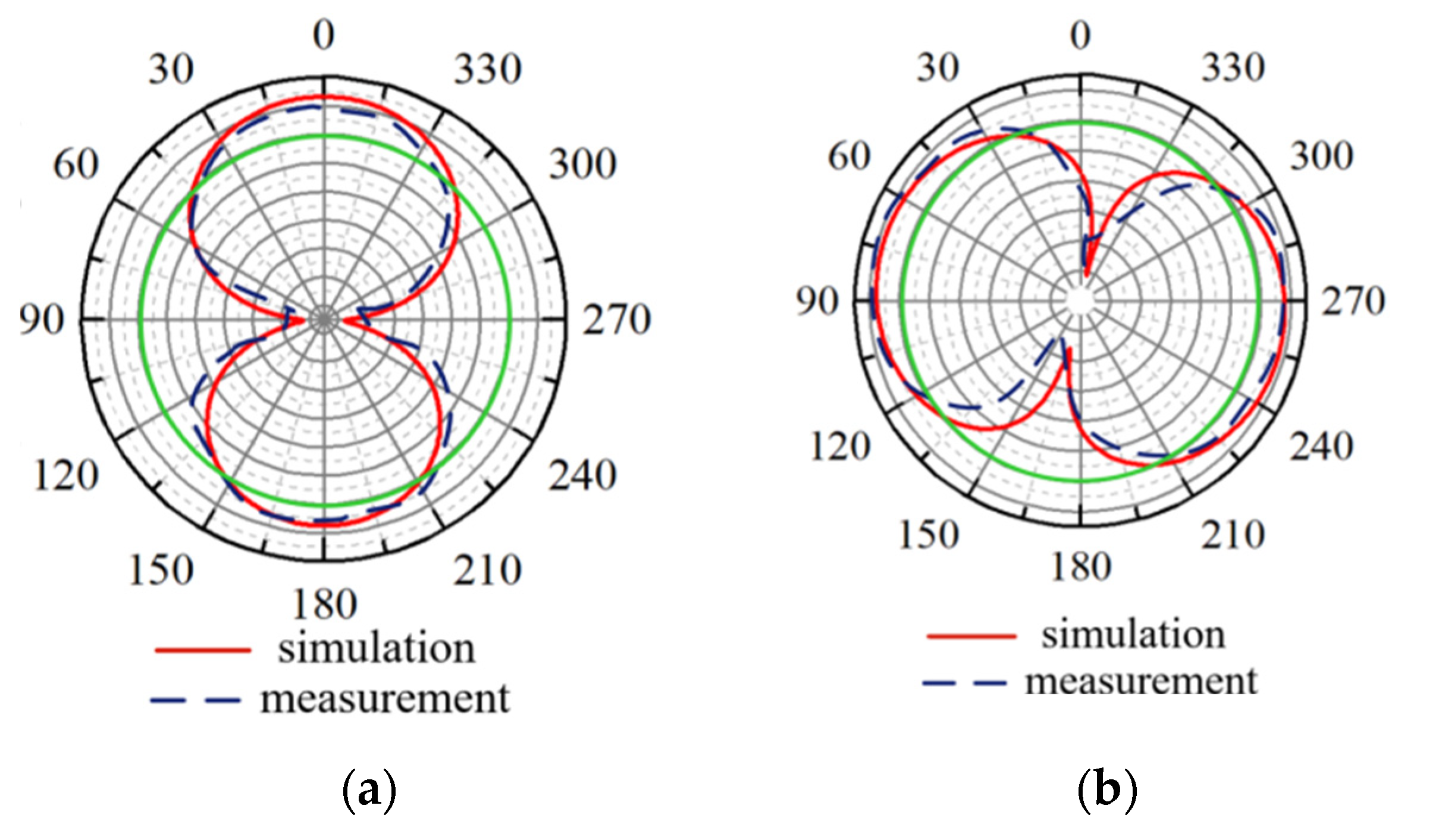
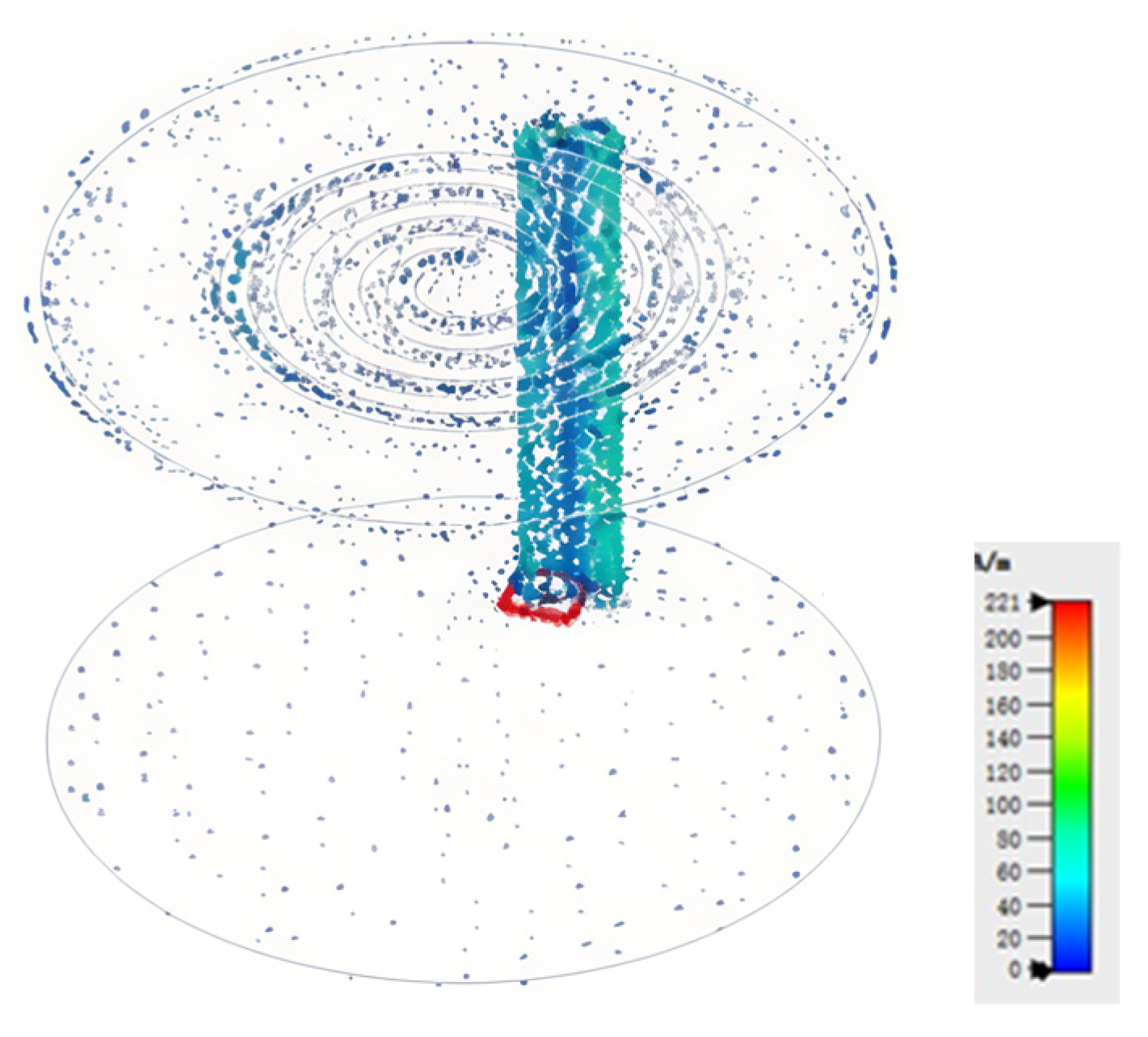
| Parameter | Definition | Value | Unit |
|---|---|---|---|
| H | Height of antenna | 22 | mm |
| D | Diameter of top & bottom plates | 30 | mm |
| c | Width of feed line | 0.6 | mm |
| r | Width of short stub | 1.2 | mm |
| x | Slot width | 1.0 | mm |
| n | Number of slot spiral turns | 4 |
| Type | Frequency Band (MHz) | Size (mm3) | S Parameter (dB) | Gain (dB) | Substrate Material (εr) |
|---|---|---|---|---|---|
| Metallic Spiral PIFA [14] | 402~405 | 24 × 20 × 1.2 | −18@403 MHz | - | 10.2 (with superstrate) |
| Metallic Spiral PIFA [18] | 402~405 | π × 4 × 4 × 0.65 | −24@403 MHz | −42.4 (in muscle) | 9.4 (with superstrate) |
| Metallic Spiral PIFA [25] | 600~800 | π × 5 × 5 × 3.2 | −19@710 MHz | −20 (in muscle) | 4.3 |
| Our work | 910~920 | π × 15 × 15 × 30 | −16@915 MHz | 2.94 (in fat) | 4.3 |
Disclaimer/Publisher’s Note: The statements, opinions and data contained in all publications are solely those of the individual author(s) and contributor(s) and not of MDPI and/or the editor(s). MDPI and/or the editor(s) disclaim responsibility for any injury to people or property resulting from any ideas, methods, instructions or products referred to in the content. |
© 2025 by the authors. Licensee MDPI, Basel, Switzerland. This article is an open access article distributed under the terms and conditions of the Creative Commons Attribution (CC BY) license (https://creativecommons.org/licenses/by/4.0/).
Share and Cite
Li, R.; Liu, J.; Sun, C.; Yao, W.; Tian, Y.; Huang, X. Design of Small-Sized Spiral Slot PIFA Antenna Used Conformally in Laminated Body Tissues. Sensors 2025, 25, 2938. https://doi.org/10.3390/s25092938
Li R, Liu J, Sun C, Yao W, Tian Y, Huang X. Design of Small-Sized Spiral Slot PIFA Antenna Used Conformally in Laminated Body Tissues. Sensors. 2025; 25(9):2938. https://doi.org/10.3390/s25092938
Chicago/Turabian StyleLi, Rong, Jian Liu, Cuizhen Sun, Wang Yao, Ying Tian, and Xiaojun Huang. 2025. "Design of Small-Sized Spiral Slot PIFA Antenna Used Conformally in Laminated Body Tissues" Sensors 25, no. 9: 2938. https://doi.org/10.3390/s25092938
APA StyleLi, R., Liu, J., Sun, C., Yao, W., Tian, Y., & Huang, X. (2025). Design of Small-Sized Spiral Slot PIFA Antenna Used Conformally in Laminated Body Tissues. Sensors, 25(9), 2938. https://doi.org/10.3390/s25092938





